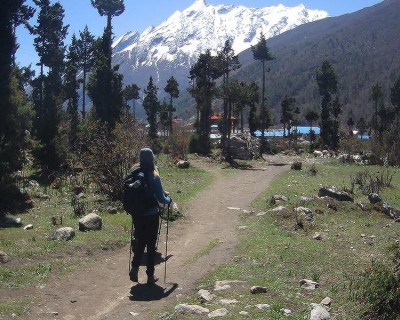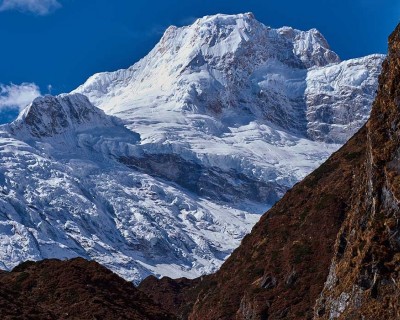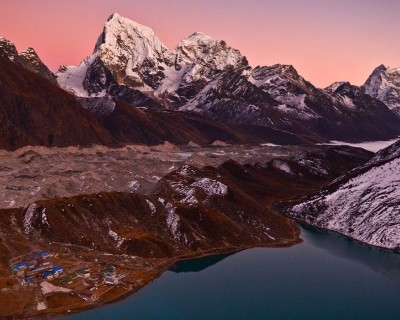Everest Base Camp Trek Weather in May
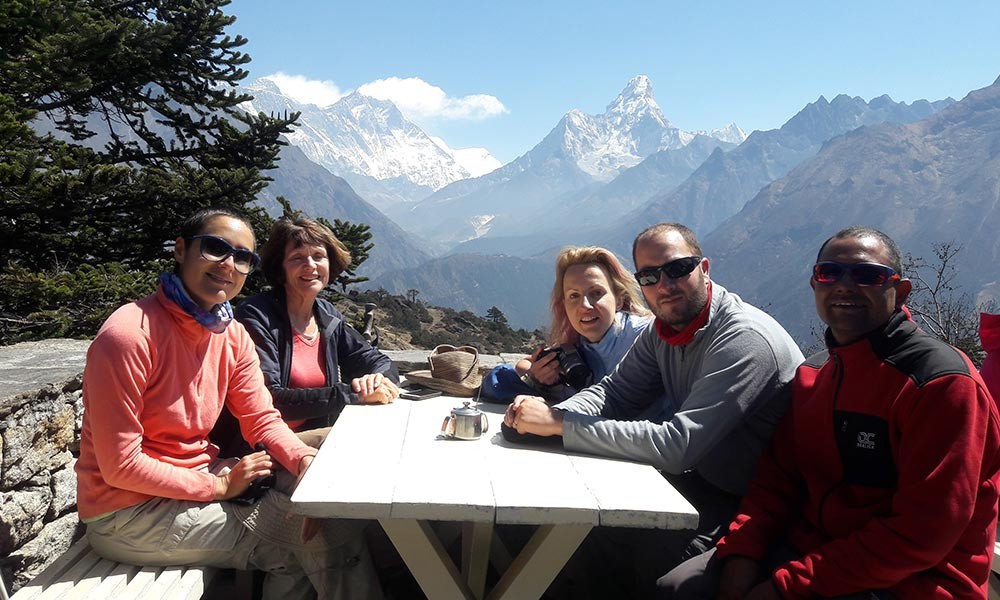
In early May, the weather conditions are considered ideal for trekking. The weather is stable and clear. The paths are dry, and the likelihood of heavy rainfall and snow is minimal.
The skies are clear without any thick clouds blocking the view. Trekking is smooth and pleasant because the trails are dry and easy to walk along. This is a popular time of year among trekkers. So, trails are full of trekkers from all over the world, which provides a social and friendly atmosphere along the trek.
During the Everest base camp trek in late May, the weather slowly changes. There is a likelihood of light rain showers, signaling the monsoon's arrival. However, this period also offers a peaceful and tranquil trekking experience because there are relatively fewer trekkers on the trails compared to the earlier part of the month.
Whether you trek in early or late May, you need to be ready for fluctuating weather conditions. You need to pack layered clothing. This helps you easily adjust to temperature shifts, which are common in the higher sections.
The daytime of this month is generally warmer for exploration, especially in the lower sections. In the higher areas, the weather is generally colder. But the cold can be tackled with layered clothing and good preparation.
Pack good rain gear as it is needed, especially in late May, because there is a chance for light rain showers. Check daily weather patterns and wear sturdy and comfortable trekking boots while trekking on the steep or rugged terrain for navigating safely. With careful planning, you can complete the May adventure smoothly while getting rewarded with an unforgettable adventure.

Everest Base Camp Temperature in May
The temperature in the Everest Region varies with elevation. May is one of the warm times with adequate sunshine. During the daytime, the average temperature in the lower elevation is around 15°C to 20°C. So, the daytime hikes are comfortable this month. However, the nights are cooler with higher elevations dropping up to 4 °C.
At the higher sections of the trail, the average maximum temperature is around 8°C, while at the night time it can drop up to - 3 °C. The air remains crisp throughout the day. Still, high altitude regions' weather is known for being unpredictable which requires you to be prepared for sudden changes. Thus, carrying enough protective layers is crucial to move comfortably along the trail.
Everest Base Camp Trek in May: The Scenery
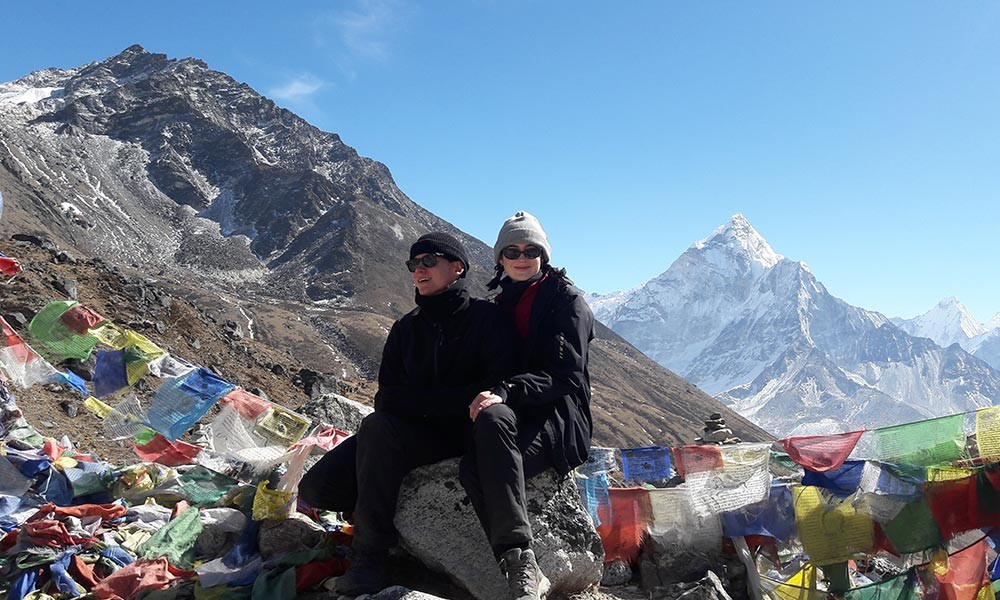
Spring fills Khumbu region with vibrant blooming flora. The hills and forests are covered with rhododendrons and many other wildflowers. The blooming Himalayan flowers look stunning with the backdrop of the snow clad peaks. In addition, the fresh spring mountain air makes your navigation pleasant and smooth.
The spring of May offers clear skies. The weather is cool, yet the sun shines brightly, and the skies are cloud-free. So, visibility is great, presenting the unobstructed and striking views of Mount Everest, Ama Dablam, Nuptse, Thamserku, Lhotse and other nearby peaks.
The scenery from the popular viewpoints along the route is magical. You will begin trekking from beautiful Sherpa villages, navigate the serene forested sections, and head towards the base camp, navigating the rugged paths. You pass through Sherpa villages with stone houses and fluttering prayer flags that look beautiful with the stunning mountain backdrop.
The traditional architecture blends perfectly with natural scenery. The combination of beautiful flowers of all colors, fresh air and stunning mountain views presented by this month ensures a wonderful and rewarding experience.
Everest Base Camp Trek in May: Trail Conditions
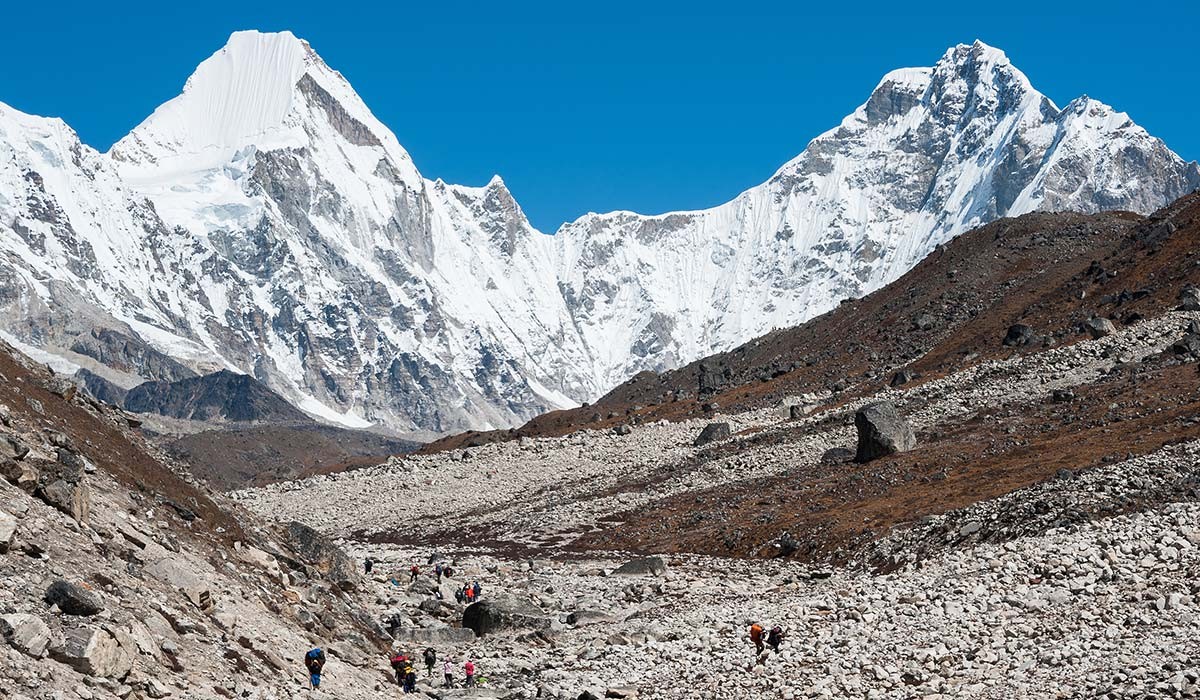
In May, the trail conditions are considered ideal for trekking. The paths are mostly free from heavy snow. In early May, there is a minimal likelihood of rain. So, the paths are well defined and easier to navigate.
The hillside and forested trail are colorful because of flowers blooming. So, you will stay captivated the entire time. Towards the end of May, there can be light shower which can make some areas slightly slippery. However, the rain showers are typically light in nature at this time, so trails are still passable with proper rain protection. But it is still advisable to stay careful while navigating.
With right footwear and proper trekking gear, you can stay safe and comfortable throughout the adventure. You can try to get real time updates of weather and trail from the guide or the teahouse owner and head outside only on secure conditions. Overall, trails in May are ideal for navigation which helps you ensure a smooth adventure.
Everest Base Camp Trek May: The Crowd Levels
May is one of the most favoured times for the majority of trekkers. The weather in May is wonderful with crystal clear blue skies and sunny days. The spring flowers decorate the trails and adds charm to this serene region.
For this very reason, a majority of trekkers from around choose this spring month. Trails are full of trekkers specially at the popular stops, requiring early reservation.
Even though the trails are packed, the longer daylight hours give you plenty of time to hike at your own pace. You may start in the morning to avoid crowds at the busier viewpoints and stopover places. This will give you enough time to admire the scenery and enjoy the serene ambiance of the region.
By late May, the trails may be relatively less crowded. The monsoon season arrives which also increases the likelihood of rain. So, some trekkers might complete the trek before mid-May to avoid rain.
Still, for those who prefer quiet adventure, late May can be a very rewarding time. The scenery is just as stunning and the weather is pleasant. You might come across few slippery spots if it rains but with proper preparation and the right gear it is manageable.
In general, May is great time to do Everest Base Camp Trek. The early part of the month is lively while the second half is relatively peaceful with the same stunning mountain vistas. You can choose to trek at any time of the month according to your personal preference.
What Can You Expect During the Everest Base Camp Trek in May?
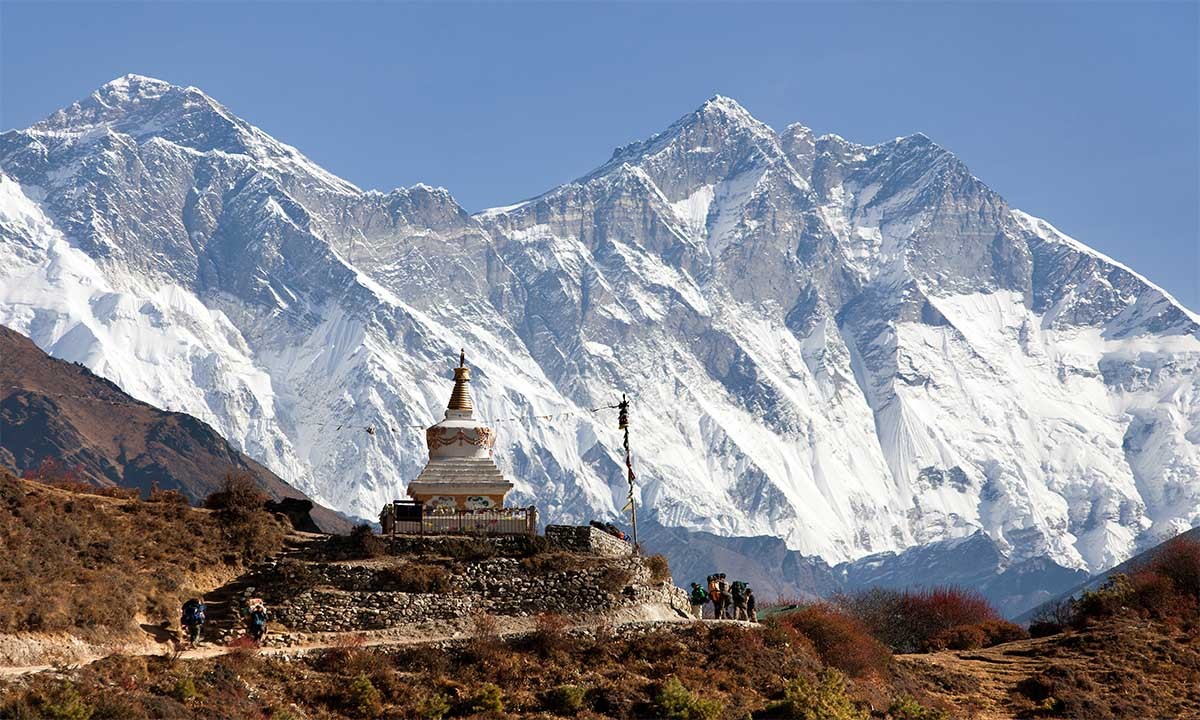
Clear Mountain Views
In May, Everest Base Camp trek offers stunning views of Himalayas. The pre monsoon period rewards you with clear weather so you can expect to witness panoramic views of massive mountains like Everest, Lhotse, Nuptse and Ama Dablam and other nearby peaks along the route.
The air at high elevations is fresh, and visibility is excellent. Further up particularly at locations such as Kala Patthar, the stunning views of summits and sunrises are truly amazing which enhances your sightseeing experience.
The visibility of the peaks, especially in the early morning hours, is excellent. The sunrise above them looks surreal and makes the hikes particularly rewarding. The unobstructed and panoramic mountain makes May ideal month for the EBC trek.
Pleasant Weather
May is quite popular time for the Everest Base Camp Trek. The climate is generally warm especially at lower elevations. You can trek in light and comfortable gear in this month.
With increasing elevation, the weather might be chilly, particularly in the evenings and at higher camps like Dingboche or Gorak Shep. However, it is still manageable with proper gear.
In the early part of May, rain is less frequent. The trails are dry and easy to navigate. There can be some light rain showers in the later part of May so packing rain gear is a must in this month.
Generally, May's mild climate helps you smoothly navigate varied terrains. This makes your exploration exciting and memorable.
Lively Villages
The villages along the Everest Base Camp trail, such as Namche Bazaar, Tengboche, Dingboche, and many others, are lively in May. It is one of the ideal trekking months.
The teahouses along the way are filled with other trekkers from around the world. So, you can enjoy the lively ambiance and get the opportunity to interact with other travellers.
You may communicate with locals, venture into colourful markets at Namche or chat with fellow adventurers at teahouses while dining. With natural beauty and vibrant atmosphere trekkers can create long lasting memories while trekking in Everest Region.
Stable Weather and Longer Daylight Hours
May is a time when the Everest Base Camp trek enjoys relatively stable weather. The consistent weather allows you to plan the days confidently because conditions are likely to be best for most of the route, with serene trails and minimal disruptions because of the weather.
The longer daylight hours of May are also major factors that attract many visitors. With early sunrise and late sunset, you have sufficient hours each day to walk daily distances, rest and make excursions to viewpoints or monasteries while still making it to the stop on time.
These extended hours also allow for flexibility, providing you with several chances to rest along the route or acclimatize comfortably. You will get enough time to enjoy the scenic vistas from the famous spots. The climate stability and increased daylight make May the ideal month for a pleasant and memorable trekking experience.
Photography Opportunities During the EBC Trek in May
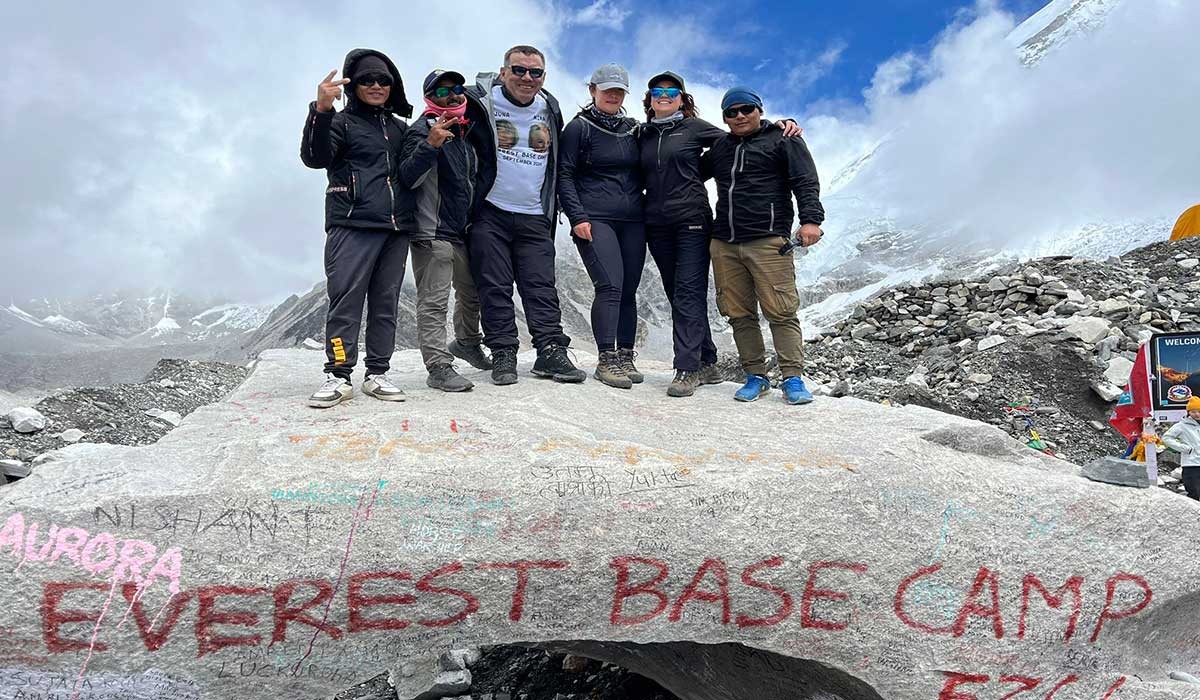
May is considered one of the favourable times for the EBC photography trek. This last spring month generally has clear blue skies. Likewise, the landscapes are vibrant because of the blooming flora. While trekking through the enchanting Sagarmatha National Park, you can take marvelous shots of rivers, suspension bridges, valleys and stunning glaciers.
You can capture beautiful rhododendrons blooming in the hillsides or forests. In addition, you can also take panoramic shots of snowy mountains from the different vantage points especially during sunrise and sunsets. The golden light shining on the mountains allows you to snap some of the most beautiful shots, which helps you showcase the beauty of Everest Region to the world.
Namche Bazaar charms visitors with its authentic Sherpa villages, vibrant market and scenic views, presenting countless picture-perfect moments. You may also visit Tengboche Monastery and photograph the scenic surrounding vistas.
Reaching Everest Base Camp and Kala Patthar are the two major highlights of the trek. Standing at the base camp of the planet’s highest peak is an unforgettable moment and you can capture this moment on your camera.
One of the popular spots from where you can shoot magical vistas is Kala Patthar. From this spot, you can capture beautiful views of the sunrise and its golden rays over the mountains. You will also get a chance to take close up snaps of Mount Everest and other surrounding snowy peaks.
The season provides photographers with a chance to capture incredible natural landscapes. In addition, they will also get a chance to document the cultural elements of the region. Overall, May's mix of natural beauty and climatic conditions is perfect for capturing awe inspiring photographs of Everest region.
Accommodation Availability and Meals for the Everest Base Camp Trek in May
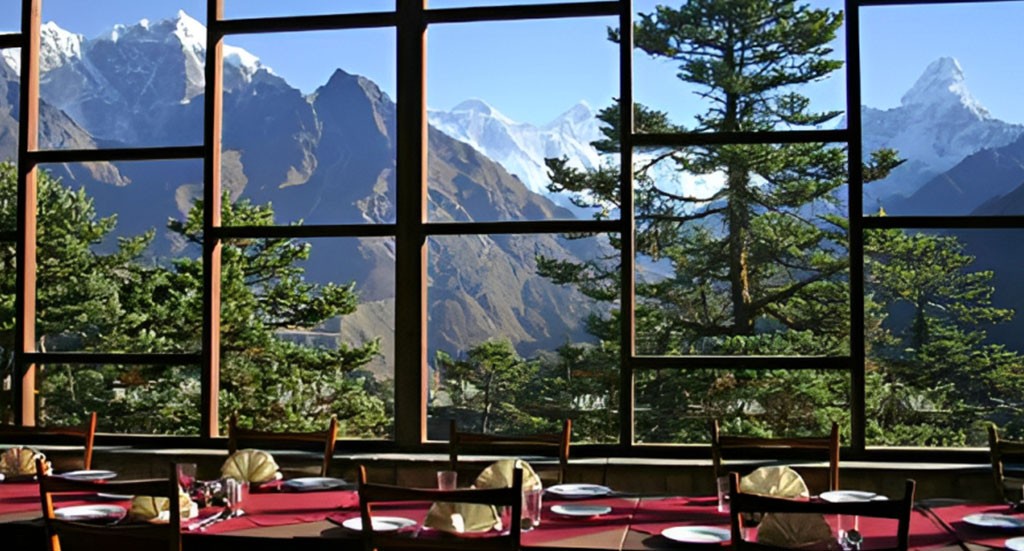
Accommodation
May is one of the peak seasons for the Everest Base Camp Trek. The weather is perfect in this month, and it also attracts several visitors from around the world. The Khumbu region is popular for trekking and there are many teahouses on the trail.
The teahouses along the trail are clean. Most of them have shared dining halls where the trekkers have meals together. You will find well-maintained and cozy rooms at almost all the stops, mostly with twin beds. Wifi, hot showers and charging facilities are also available at the teahouses, for which you may need to pay extra.
However, the region gets several visitors in May, which makes finding comfortable rooms quite difficult. Because rooms fill up fast in this peak trekking season, you can book your accommodation in advance.
If you opt for the trek package, the accommodations will be arranged for you, ensuring you have a comfortable stay even during this peak trekking season.
Meals
Including healthy and nutrient rich meals is essential on the trek because it provides you with energy to walk for long hours in the mountains. Teahouses on the Everest trail serve nutritious and delicious meals which help trekkers have full energy to walk through the varied terrains of the Khumbu Region.
Some common items that are available are Dal Bhat, thukpa, pasta, momo, noodles, potatoes, soup, Sherpa stew, eggs, sandwich, toast, and porridge. In popular areas like Namche Bazaar, several restaurants serve a variety of popular international dishes and desserts.
Generally, trekkers have breakfast and dinner in the teahouses where they stay. For lunch, they can choose any of the stops or eateries along the trail. These simple and filling meals provide you with the energy and strength you need for the entire Everest trek.
What to Pack for a Smooth and Comfortable Everest Base Camp Trek in May?
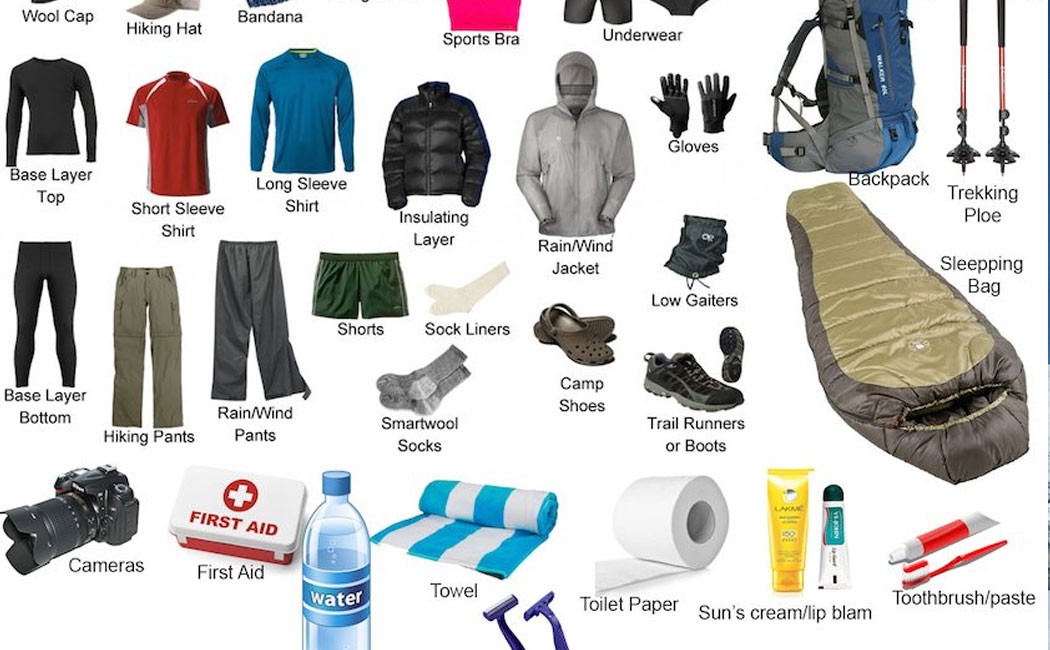
Packing smart makes the trek much more pleasant. You may aim to pack light, make sure to try your best not to leave out the essentials.
Himalayan weather can change quickly with the winds. So, it is essential to bring enough warm layers and also quality footwear.
You need to create a packing list and pack all essentials accordingly which helps you stay organized, save space, and still have all the essentials that keep you comfortable, warm, and safe on the trail.
Here are the recommended items that you need to pack for the EBC trek in May:
Clothing
Fleece jacket
Trekking T-shirts
Lightweight down jacket
Windproof jacket
Cap
Beanie
Woolen sweater
Waterproof jacket
Sun hats
Quick dry trekking pants
Insulated Gloves
Buff
Lightweight gloves
Footwear
Essential Gears
Trekking poles
Daypack and Rain cover
Headlamp
Sleeping bag
Flashlight
Required Trekking Essentials
Toothbrush and toothpaste
Quick dry towel
Lip balm
Hand sanitizer
Shampoo
Toilet paper
Tissues
Sunscreen
Power bank
High-energy snack
Biodegradable soap
Camera
Smartphone
Reusable water bottles
Personal medications
First aid kit
Wet wipes
Trekking permits
Passport
Route map
Water purification tablets
Oral Rehydration Solutions
Why is Travel Insurance Required for the Everest Base Camp Trek?
.jpg)
Everest Base Camp Trek rewards trekkers with a memorable experience However, it is a high altitude adventure that has certain challenges. For about 12 to 14 days, trekkers will navigate the diverse terrains.
While trekking in the varied terrain is exhilarating, it also comes with certain risks like altitude sickness or weather-related disturbances. Likewise, some people may fall ill and require emergency evacuation.
For treks like Everest Base Camp you need to choose an insurance policy that is required for high altitude trekking. Make sure it covers for the helicopter evacuations.
It should also provide coverage for medical treatment for sickness, injury or high altitude illness, plus cancellations or postponements of the trek. By having insurance that provides coverage for high altitude trekking, you can trek with peace of mind.
Importance of Altitude Adjustment During the Everest Base Camp Trek
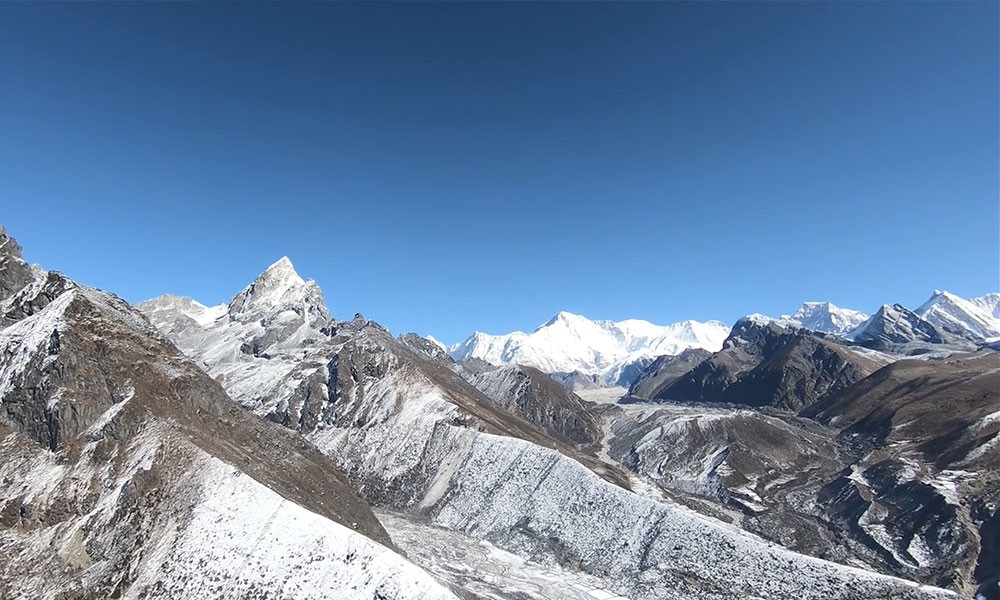
Altitude adjustment is essential during the Everest Base Camp Trek. No matter which month of the year you choose for the trek, getting accustomed to the high altitude is a must to stay healthy and comfortable.
During this trek, you will be at the different high altitude stops that range from 2500 meters to 5,000 meters. The oxygen levels are significantly lower at high altitudes. If you can't adapt, you are more likely to experience the symptoms of altitude sickness.
May has ideal trekking weather and trails. So, navigation can be easier but the risk of altitude sickness is still there, which requires proper acclimatization. Some symptoms of altitude sickness include appetite loss, feeling tired, headache, dizziness, nausea and difficulty sleeping.
Gradual ascent, following the scheduled acclimatization days, maintaining good hydration and having balanced meals throughout the journey can help you adapt to the Himalayan environment.
Generally, during this trek trekkers keep acclimatization days at Namche Bazaar and Dingboche. So, make sure your Everest Base Camp Trek in May itinerary has rest days in these places.
Make sure you are attentive to your body's reaction as you gain altitude and if you experience symptoms that do not get better, then descend to the lower zones.
You may consider taking altitude sickness medications but ensure that you take advice from your doctor first. Altitude adjustment during high altitude trek is essential to acclimatize, which helps you complete your adventure smoothly.
Tips for the Everest Base Camp in May
For a smooth and secure traversing experience, we recommend that you train for the trek at least 3 to 4 months in advance including cardio and strength exercises.
Do research about the Everest Base Camp May weather and trail conditions and be mentally prepared for tackling trek difficulty.
Dress in layers and pack rain gear, as in late May, there are possibilities of light rain showers.
Start trekking early in the morning and enjoy exploration under extended daylight.
Trek only through the designated trails.
Choose to trek with guide and porters.
Check real time weather and head out only on secure conditions.
Always be attentive to the guidance provided by trekking guides.
Walk only through designated paths.
Be flexible to adjust your itinerary when needed.
Also Read: Everest Base Camp Trek in April
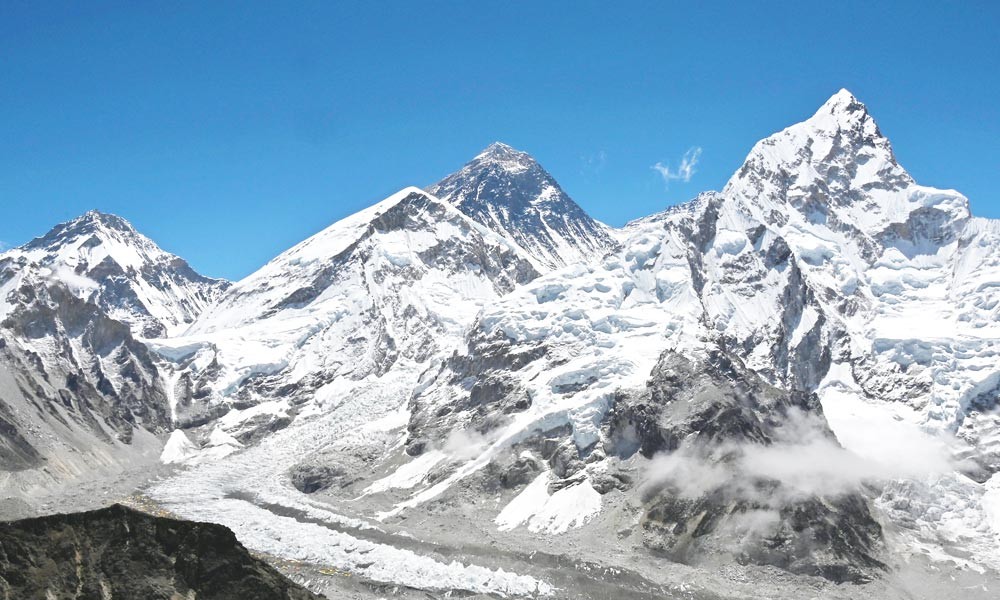










.jpg)

